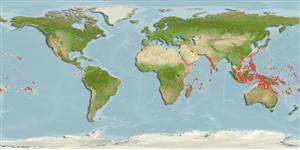Environment: milieu / climate zone / depth range / distribution range
Ecologia
marino associati a barriera corallina; distribuzione batimetrica 15 - 53 m (Ref. 11441). Tropical
Indo-Pacific: Known from the Society Islands, Hawaiian Islands, Palau (Myers, 1999), Solomon Islands, Great Barrier Reef, Ryukyu Islands (Senou et al., 2004), Gulf of Thailand, Indonesia (Randall, 2005), Chagos Archipelago, Maldive Islands (Kuiter, 1998), and Oman (Randall, 1995). Reported as a first record for the Red Sea from an underwater photograph taken by Sven Kahlbrock off Hurghada, Egypt (Ref. 89154). Maldives (Ref. 30829) and Chagos Archipelago to the Hawaiian Islands.
Size / Peso / Age
Maturity: Lm ? range ? - ? cm
Max length : 2.5 cm SL maschio/sesso non determinato; (Ref. 59154)
Short description
Chiavi di identificazione | Morfologia | Morfometria
Spine dorsali (totale) : 6 - 7; Raggi dorsali molli (totale) : 7; Spine anali: 1; Raggi anali molli: 8 - 9. Dorsal-fin rays VI + I,7 or I,8 (usually I,8); anal-fin rays usually I,8 or I,9; pectoral-fin rays 12–14 (usually 13); anteriormost scales on body usually reaching to above or a little anterior to pectoral-fin base, the longitudinal scale series 32–59 (mean scale count 47); body elongate, the depth at origin of anal fin 11.6–14.5 % SL; head width about equal to head depth; snout length about equal to orbit diameter; gill opening small, reaching ventrally to below or just anterior to lower edge of pectoral-fin base; mouth slightly inferior; a recurved canine tooth (or pair of teeth) at side of lower jaw; lower edge of preopercle slightly scalloped; caudal fin truncate with rounded corners; pelvic fins short, round, and cup-like, the pelvic spines and frenum thickened; dorsal two-fifths of body transparent, crossed by six or seven narrow bars that may be yellow, dusky orange, or red, with a small spot of the same color dorsally between each bar; a white line above vertebral column; lower three-fifths of body dusky to blackish orange. Largest specimen, 24.5 mm (Ref. 89154).
Inhabit deep slopes, subject to strong currents, with isolated outcrops of black corals (Ref. 48637). Benthic (Ref. 58302). Found in small groups. Eggs are laid on a branch section after removing the polyps and guarded by the male (Ref. 48637). Associated with antipatharian corals at depths below 15 m (Ref. 2334). Dart out to feed on small animals of the plankton (Ref. 11441).
Life cycle and mating behavior
Maturità | Riproduzione | Deposizione | Uova | Fecundity | Larve
Randall, J.E., G.R. Allen and R.C. Steene, 1990. Fishes of the Great Barrier Reef and Coral Sea. University of Hawaii Press, Honolulu, Hawaii. 506 p. (Ref. 2334)
IUCN Red List Status (Ref. 130435: Version 2024-2)
Threat to humans
Harmless
Human uses
Pesca: commerciale; Acquario: Commerciale
Strumenti
Special reports
Download XML
Fonti Internet
Estimates based on models
Preferred temperature (Ref.
123201): 24.7 - 28.9, mean 27.7 °C (based on 430 cells).
Phylogenetic diversity index (Ref.
82804): PD
50 = 0.5000 [Uniqueness, from 0.5 = low to 2.0 = high].
Bayesian length-weight: a=0.00724 (0.00339 - 0.01546), b=3.10 (2.92 - 3.28), in cm total length, based on LWR estimates for this (Sub)family-body shape (Ref.
93245).
Trophic level (Ref.
69278): 3.4 ±0.45 se; based on food items.
Resilienza (Ref.
120179): Alto, tempo minimo di raddoppiamento della popolazione meno di 15 mesi (Preliminary K or Fecundity.).
Fishing Vulnerability (Ref.
59153): Low vulnerability (10 of 100).
